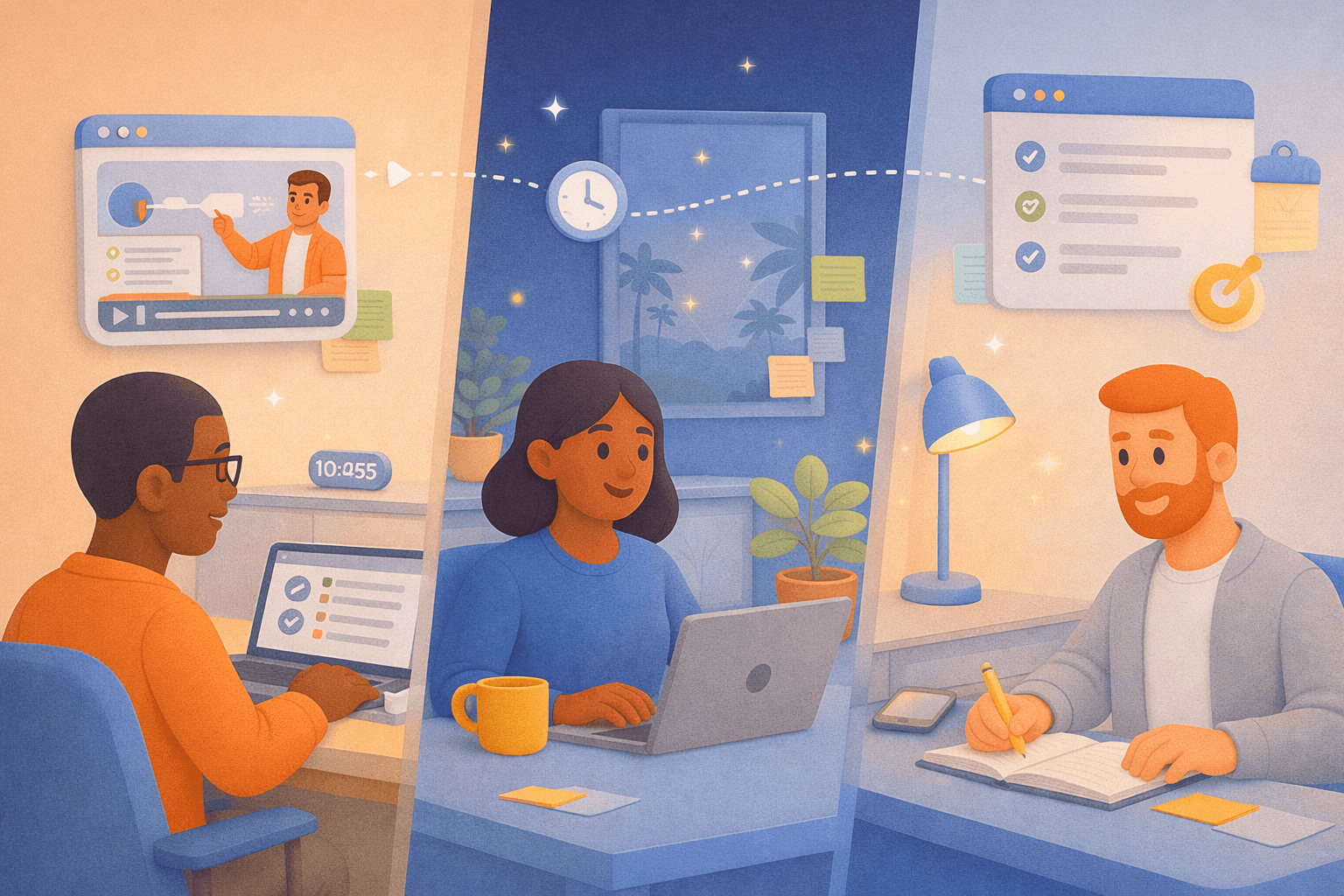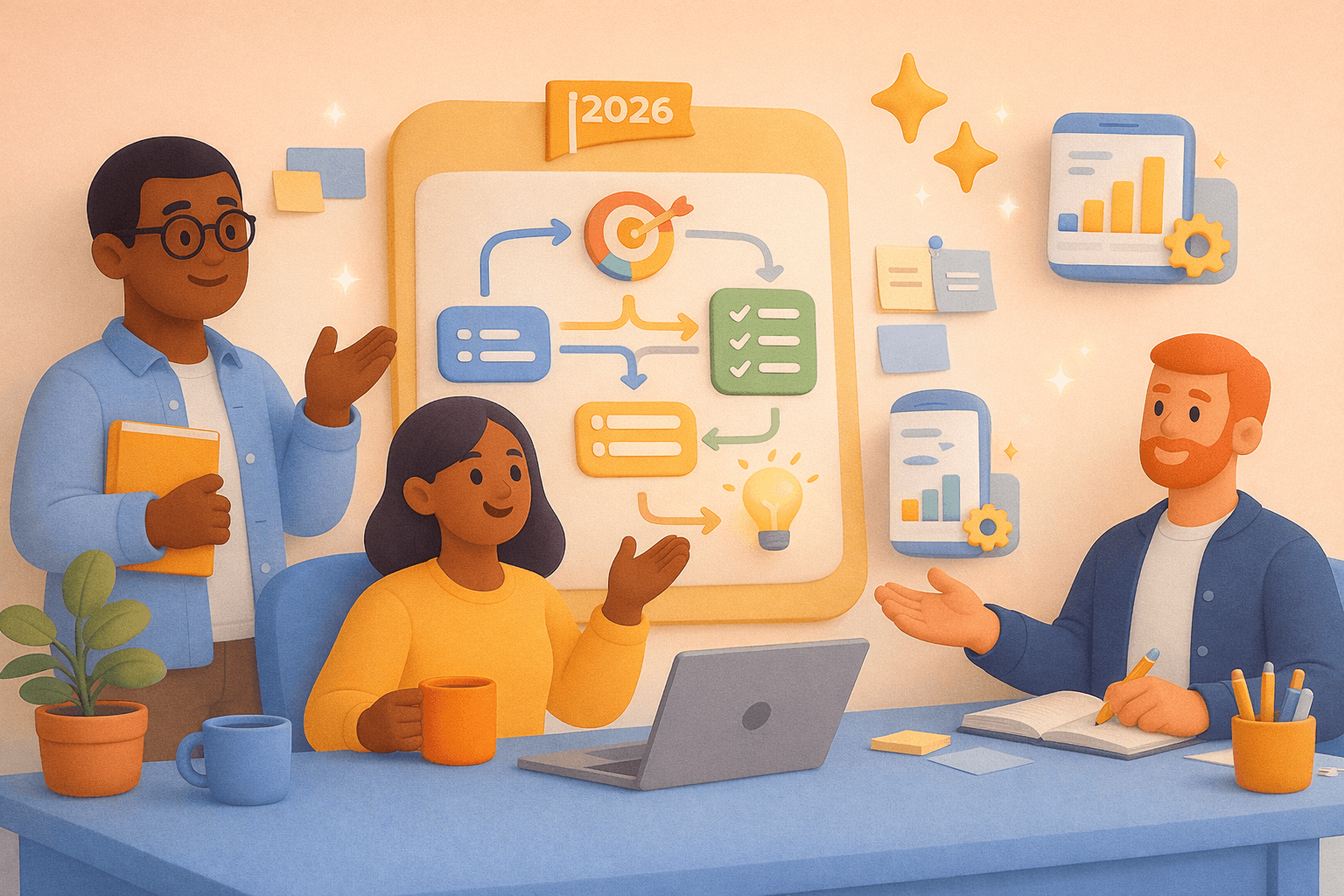Curating knowledge
Convert PowerPoint slides into interactive E-learning courses
Convert PowerPoint slides into interactive e-learning courses with AI. Make training engaging, trackable, and free from complex tools or licenses.

Ryan Macpherson
Aug 31, 2025



Convert PowerPoint Slides Into Interactive E-Learning Courses
Every company has them. Buried on desktops. Passed around in emails.
We’re talking about PowerPoint presentations. Most companies recycle presentations as part of their knowledge-sharing or training efforts.
But they’re built for meetings, not learning. A PowerPoint presentation can’t track learner progress, add interactivity, or guide someone at their own pace. And let’s be honest, PowerPoint has the power to make people fall asleep.
Teams need more. With modern authoring tools, it’s now possible to turn static slides into interactive elearning modules that actually move knowledge forward. And make learning super fun.
What does it mean to convert PowerPoint to e-learning?

Converting PowerPoint presentations into elearning courses means taking slides designed for live delivery and transforming them into self-paced experiences – without starting from scratch. All the work that went into the presentation stays intact, but it’s delivered in a format built for learning.
A presentation depends on a speaker. E-learning removes that dependency, making the content interactive, trackable, and available anytime.
Think of it this way: a deck might explain a new product feature, but without context, it’s just text and images. When you convert your PowerPoint, you create a guided pathway that feels like a course, complete with interactive elements like:
Quizzes
Navigation
Downloadable resources
This shift matters because the presentation mindset assumes learners are in the room. A fully functional e-learning course assumes they’re learning at their own pace, on their own devices.
And the good news? You don’t need an expensive license or specialist skills to make the switch. With modern AI-powered tools like Coassemble, teams can convert PPT into interactive elearning modules for free. No credit card. No free-trial time limits.
Why convert PowerPoint presentations to e-learning?
PowerPoint slides end up carrying more weight than they should. They get emailed as “training,” uploaded to a shared drive, or reused year after year, another form of messy documentation that leaves knowledge stuck instead of shared. But elearning PowerPoint presentations built this way rarely deliver lasting impact.
The problem with standalone PowerPoint files
No way to track learner progress or engagement
Heavy PPT files that are awkward to share
Static slides with no interactive activities
Zero visibility into whether people actually learn anything
Benefits of converting to elearning format

Clear analytics to see who completed the course and where they struggled
Interactive content like quizzes, polls, and branching scenarios
Mobile-ready so learners can complete online training on mobile devices at their own pace
Easier updates and centralized management for consistent learning content
Instead of passing around decks, teams can convert PowerPoint into an interactive experience that feels like a true e-learning course. This shift creates a way to communicate knowledge reliably, measure impact, and improve the learning process over time.
Methods to convert PowerPoint to elearning
The right approach depends on your team’s size, budget, and technical skills. Here are three common methods.
AI-powered transformation (the smart option)

Here’s where things have changed. Modern AI PowerPoint converters go beyond simple export. They take PowerPoint into an interactive course with navigation, knowledge checks, and even interactive assessments.
For example, Coassemble’s AI course generator can take your sales deck and, in just a few clicks transform it into a branded interactive e-learning module—complete with adding quizzes to check understanding.
Direct upload to a learning management system (the quick option)

Some teams simply upload presentations or convert them into PDFs and drop them into a learning management system. It’s fast, and in certain cases (like sharing a simple policy update), it works.
But here’s the catch: these uploads are still static. Learners can view slides but can’t interact, and you can’t measure much beyond access. For a fully functional e-learning experience, you’ll need more than file hosting.
Convert to SCORM format (the compatible option)

SCORM is the long-standing standard for sharing e-learning modules across different systems. Using a PowerPoint to SCORM converter, you can make decks compatible with most LMS platforms. This unlocks completion tracking and some analytics.
Traditional authoring tools have offered SCORM export for years. But they come with steep licenses and a learning curve that often requires an instructional designer. For growing SaaS companies, this can feel like overkill.
Choosing the right conversion approach for your team
Not every team needs the same solution. A startup looking to create an online course for onboarding has different needs than an L&D department managing hundreds of e-learning modules. The key is to start with your constraints, not with a feature checklist.
Start with your constraints, not features
Budget - Enterprise authoring tools like iSpring Suite may be powerful, but they can cost thousands per year. Many teams now look for the best alternative to LMS that’s flexible and affordable. Free or affordable platforms like Coassemble give growing teams a way to convert PowerPoint without burning budget.
Time - Do you have weeks for instructional design work, or do you need a simple tool that gets your new elearning course live quickly?
Technical skills - If you don’t have an instructional designer on staff, the platform should let you create elearning content without specialist expertise.
Essential questions for your team
Do you need detailed analytics on learner progress?
Do you have a lot of valuable PowerPoint presentations that can be turned into an interactive course?
How often will you update your training content?
Will learners access courses mainly on mobile devices?
Do you already use a learning management system, or do you need something lighter?
Implementation considerations
Free vs. paid - Many platforms advertise free trials but lock publishing behind paywalls. Coassemble stays free for one creator with unlimited e-learning courses.
Learning curve - Some authoring tools require formal training. AI-powered platforms can help you convert PPT faster with less friction.
Integration - Consider whether the tool fits your workflow, whether that’s exporting SCORM, embedding in Slack, or sharing links directly.
By weighing these questions, you can pick a path that balances cost, speed, and quality.
Best practices for effective PowerPoint conversion
How you design and refine the content determines whether learners remember or forget your material the next day. Research shows that people lose up to 70% of new information within 24 hours if it’s delivered passively. That’s why adding structure, interactivity, and reinforcement is essential.
Prepare your content before converting
Go through your PPT presentations and check if each slide makes sense without a presenter explaining it. If not, that’s a cue to add interactivity or provide extra context. This is also the stage to plan downloadable resources: short guides or checklists that reinforce your core message and help learners revisit the material later.
Design for self-paced learning

When you turn a presentation into a learning experience, shorter segments work best. Instead of one long deck, break it into focused lessons. Adding interactive activities, knowledge checks, and interactive assessments not only makes the content engaging; it also improves retention.
Microlearning formats that use these elements can deliver up to 50% higher engagement compared to static training. Quizzes, branching scenarios, and progress indicators guide learners through the learning process, while thoughtful course design ensures clarity at every step.
Test and iterate
Treat every converted course as a draft. Run a pilot with a small group of learners, gather feedback, and refine based on what you see in completion rates and usability. For example, if you notice learners dropping off on a specific slide, review the slide and determine what may have caused the drop-off.
Small adjustments based on learner feedback can significantly boost retention and satisfaction. The aim isn’t polished slides, but a fully functional course that helps you communicate knowledge with clarity and gives learners confidence to learn at their own pace.
When you apply these practices, your e-learning PowerPoint projects shift from static decks into dynamic interactive content that people actually want to complete and remember.
Wrapping Up
PowerPoint presentations were never designed to be courses. They’re snapshots, meant for the room, not for the learner. But the reality is that many teams still rely on them as “training,” even though they can’t track progress, add interactivity, or guide someone at their own pace. By choosing the right approach, whether it’s a quick upload, SCORM compatibility, or an AI-powered transformation, you can convert your PowerPoint into a true e-learning course without expensive licenses or specialist skills. Best practices like preparing content carefully, designing for self-paced learning, and testing with small groups make the difference between a static deck and an engaging interactive elearning module.
The old way required heavy authoring tools or hiring an instructional designer. Today, platforms like Coassemble make it possible to create a fully functional elearning course for free. No credit card, no 7-day trapdoor. Just knowledge in motion, ready for learners to access when they need it most.
Your team already has the content. The opportunity is in moving it forward. With modern tools, you can turn every slide into interactive content that communicates knowledge, tracks outcomes, and grows with your business.
FAQs about converting PowerPoint to elearning
Can I convert PowerPoint to elearning for free?
Yes. With tools like Coassemble, you can convert PowerPoint into a fully functional elearning course for free.
Do I need technical skills to convert PowerPoint presentations?
No. Modern AI PowerPoint converters let you create elearning modules in just a few clicks, without needing an instructional designer or advanced skills.
Will my PowerPoint animations and formatting be preserved?
Most authoring tools will carry over text and images, but complex animations may not transfer perfectly. Testing and light editing ensure your elearning PowerPoint looks right.
How long does it take to convert a PowerPoint presentation to elearning?
It depends on the tool. Traditional authoring tools can take hours, but with AI platforms, you can convert PPT into an interactive course in minutes.
Can I add quizzes and interactive elements during conversion?
Yes. Modern platforms allow you to add interactive assessments, knowledge checks, and other interactive elements to transform slides into engaging elearning content.
Read More
Join the knowledge revolution today
Unlock knowledge. Boost engagement. Drive results
No credit card required

Join the knowledge revolution today
Unlock knowledge. Boost engagement. Drive results
No credit card required

Join the knowledge revolution today
Unlock knowledge. Boost engagement. Drive results
No credit card required




